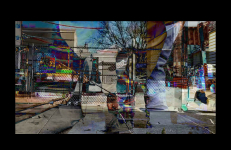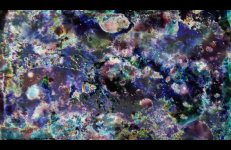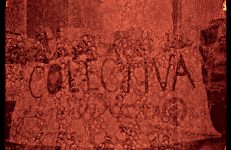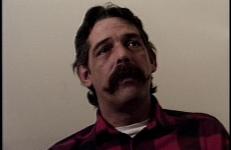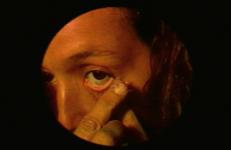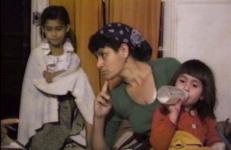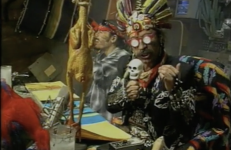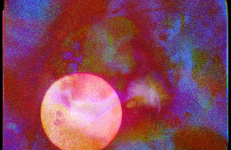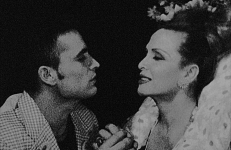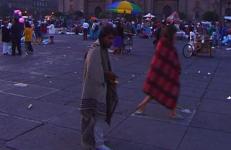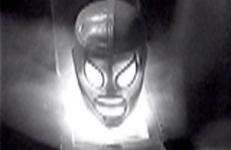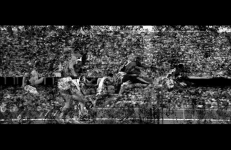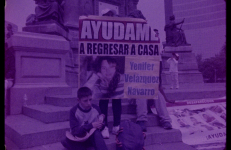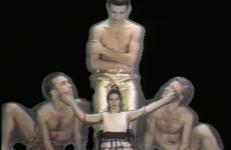History haunts the border town of Columbus, New Mexico when riders on horseback cross the border to commemorate Pancho Villa's 1916 raid.
Latino/Chicano
These are the ghosts of a haunted civilization, a culture of progress that hides the social and political horror behind the streets. These are the haunted figures in the Capitalocene era. A sinister dance of macabre abstraction. A scanner darkly of the streets. Part of the Hauntology series.
As a "Post-Mexican” performance artist operating out of the US for over 20 years, one of my conceptual obsessions has been to constantly reposition myself within the hegemonic maps. Whether this map is the Americas, the larger cartography of art, or my personal biography, one of my jobs has been to move around, cross dangerous borders, disappear and reappear somewhere else, and in the process create "imaginary cartographies” capable of containing the complexities of my multiple and ever-changing identities, voices, communities and performative bodies.
As a "Post-Mexican” performance artist operating out of the US for over 20 years, one of my conceptual obsessions has been to constantly reposition myself within the hegemonic maps. Whether this map is the Americas, the larger cartography of art, or my personal biography, one of my jobs has been to move around, cross dangerous borders, disappear and reappear somewhere else, and in the process create "imaginary cartographies” capable of containing the complexities of my multiple and ever-changing identities, voices, communities and performative bodies.
The Dresden Codex is a prehispanic book that was kidnapped and was rediscovered in the city of Dresden, Germany. It keeps a presage of a destruction to come.
In Dry Blood (Sagre Seca), various historical moments of political activism in Mexico are superimposed and corroded on the emulsion of expired film. Footage from the International Women's Day in 2017 is coupled with the recording of a powerful speech about the gruesome aftermath of the 2006 civil unrest in San Salvador Atenco.
Felipe Ehrenberg is a prominent Mexican artist who has been actively producing interactive political art, installations, and murals for more than 30 years. Also a writer, Ehrenberg has run a small press in Mexico City and has published numerous articles for art journals in the United States.
Interview by Carol Becker.
"The palms of Lana Turner's hands were full of scars; the technique she used in order to achieve melodrama was to tighten her fists, digging her fingernails into them until she began to cry. Day after day, soap opera actresses smear Vick's Vaporub into their eyes in order to cry. The effect of these false tears are the tears of the public. In Devil in the Flesh we see the camera's tricks, and even so the action seems dramatic.
The first installment of The Mexican Tapes: A Chronicle of Life Outside focuses on Hock’s status in the community. At first Hock is the “outsider,” the tourist who doesn’t understand his neighbors’ jokes. It's only months later that he becomes a close friend, travelling back to visit Mexican homes and families, and beginning to empathize with their struggles.
In English and Spanish with English subtitles.
Interrupting the nightly news in an act of guerrilla television, Gómez-Peña returns to the persona of a Chicano-Aztec veejay—"The Mexican who talks back, the illegal Mexican performance artist with state of the art technology"—to elaborate the complications of American identity. This post-NAFTA Cyber Aztec pirate commandeers the television signal from his underground "Vato bunker", where virtual reality meets Aztec ritual. Gómez-Peña embodies the doubly radical Chicano performance artist, delivering radical ideas through a radical form of entertainment.
Interrupting the nightly news in an act of guerrilla television, Gómez-Peña returns to the persona of a Chicano-Aztec veejay—"The Mexican who talks back, the illegal Mexican performance artist with state of the art technology"—to elaborate the complications of American identity. This post-NAFTA Cyber Aztec pirate commandeers the television signal from his underground "Vato bunker", where virtual reality meets Aztec ritual. Gómez-Peña embodies the doubly radical Chicano performance artist, delivering radical ideas through a radical form of entertainment.
Interrupting the nightly news in an act of guerrilla television, Gómez-Peña returns to the persona of a Chicano-Aztec veejay—"The Mexican who talks back, the illegal Mexican performance artist with state of the art technology"—to elaborate the complications of American identity. This post-NAFTA Cyber Aztec pirate commandeers the television signal from his underground "Vato bunker", where virtual reality meets Aztec ritual. Gómez-Peña embodies the doubly radical Chicano performance artist, delivering radical ideas through a radical form of entertainment.
In the nest of the sun, Xolotl, Huitzilin and Xochitl meet to recover the dance of radiation, whose colorful heat stirs the new fire of their cosmic dance. Part of the Film Tonalli.
In the second installment of The Mexican Tapes, Hock begins to participate more in the family life of La Colonia, attending baptisms and helping shop for new cars. Hock interviews the white residents of the complex who resist the Mexican community, and rumor that it will soon be torn down.
This title is also available on The Mexican Tapes: A Chronicle of Life Outside the Law
The Dream of the Darkest Hour takes the intrigue and mystery of Bobe's other works but exacerbates it in such a way that it is overpowered by aesthetics and experimental tonality. Within how limited its elements are, each one of them plays a fundamental role since without one, the others tend to remain in the air.
El Zócalo is an observational portrait of Mexico City’s central Plaza de la Constitutión during one day in August. Soldiers, Aztec dancers, clowns, food vendors, protestors, rain, dogs, tourists, kites, balloons, and dignitaries all meet in the public space of the Zócalo. This documentary presents daily life in one of the largest and most vibrant urban centers in the world, but it begins with a dream of history and ends with a dream of the space full of people for a Zapatista rally.
El Zócalo is an observational portrait of Mexico City’s central Plaza de la Constitutión during one day in August. Soldiers, Aztec dancers, clowns, food vendors, protestors, rain, dogs, tourists, kites, balloons, and dignitaries all meet in the public space of the Zócalo. This documentary presents daily life in one of the largest and most vibrant urban centers in the world, but it begins with a dream of history and ends with a dream of the space full of people for a Zapatista rally.
The Pyramid used to be a mountain.
"In the film, images of plants, rocks and occasional mountaintops flicker by so quickly they almost evade perception. Extreme colour-tinted close-ups and the use of a rhythmic, drum-forward jazz soundtrack create an effect of a syncopated collage of geometric forms. The collective seems to call into question the audience’s ability to ascertain the significance – whether historical or geographical – of the vaguely identified, eroded sites presented."
–Ela Bittencourt, Frieze
Coco Fusco is a Cuban-American artist and author who investigates race, gender, politics, and identity through installations, performances, video work, and writing. In her second On Art and Artists interview, Fusco discusses her recent works with Romi Crawford — an art historian at the School of the Art Institute of Chicago — and describes how she has evolved as a storyteller over her career.
In The Great Mojado Invasion (The Second US - Mexico War), writer/performer Guillermo Gómez-Peña and filmmaker Gustavo Vazquez combine Chicano wit and political vision to create an ironic, post-millennial and postmodern look at the future of U.S./Mexican relations. Both artist and director generate a complex commentary on history, society, pop culture, the politics of language and the repercussions of ethnic dominance.
In The Great Mojado Invasion (The Second US - Mexico War), writer/performer Guillermo Gómez-Peña and filmmaker Gustavo Vazquez combine Chicano wit and political vision to create an ironic, post-millennial and postmodern look at the future of U.S./Mexican relations. Both artist and director generate a complex commentary on history, society, pop culture, the politics of language and the repercussions of ethnic dominance.
Since the turn of the century, popular media in the U.S. have promoted a stereotyped image of Latin America in order to justify the concept of U.S. dominance in the hemisphere. The Gringo in Mañanaland uses travelogues, dramatic films, industrial films, newsreels, military footage, geographical textbook illustrations, and political cartoons to take a detailed look at United States media representations of Latin America. This video is not a dry document or didactic lesson: it is a look at history and the telling of history.
These are the ghosts of a haunted civilization, a culture of progress that hides the social and political horror behind the Olympic Games. These are the haunted figures in the Capitalocene era. A sinister dance of macabre abstraction. Part of the Hauntology series.
Mother’s Day in Mexico is considered one of the most important family holidays of the year. Thousands of mothers have nothing to celebrate. They are the mothers of victims of forced disappearances. Mothers and relatives of the disappeared participated in the "March of National Dignity. Mothers searching for their Sons, Daughters and Justice."
This dreamlike, poetic video provokes the viewer to question the nature of the most human of experiences. The collage aesthetic exposes how human relationships—between men and women, men and men, women and women—are mediated by dominant ideologies as represented in the mass media and religion. Bobe posits no theories and draws no conclusions, leaving the viewer with a truly postmodern conundrum about life, love, art, men, women and death.




